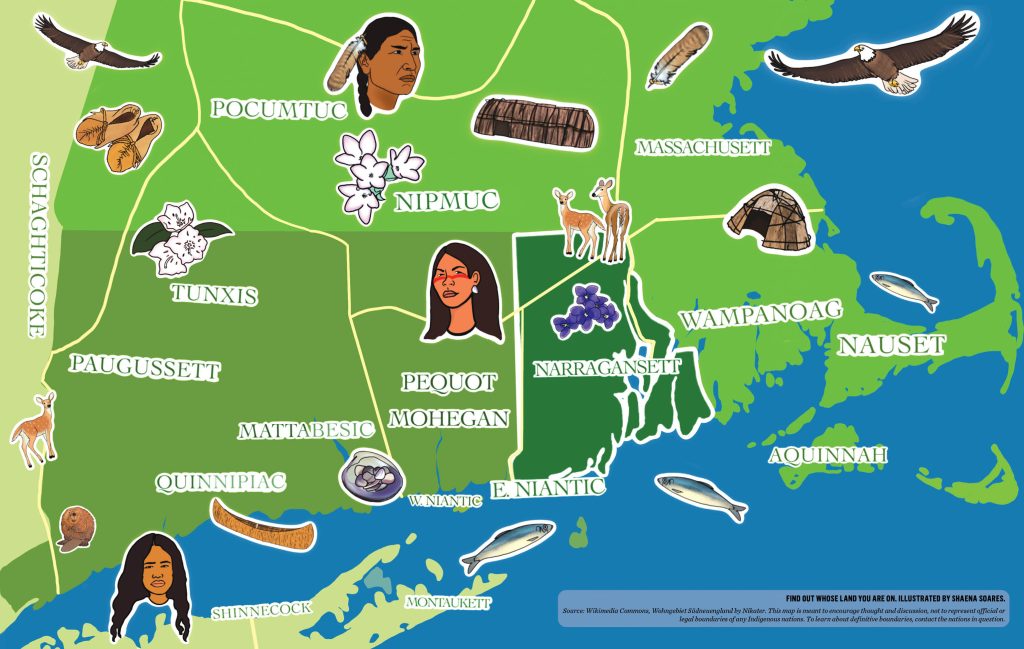It’s a well-known fact that Rhode Island is the smallest state in the country – an hour and you’ll find that you’ve driven across the whole state (okay, let’s be honest, an hour and a half with the potholes and traffic). You might think you know everybody here – somebody’s cousin is somebody’s grandpa’s neighbor, and then they’re your coworker and the person in line behind you for a coffee milk. But make no mistake: Native Americans have been around since before the official founding of Rhode Island, and they aren’t going anywhere.
I sat down with Tia-Alexi Roberts – guest editor for the current Motif issue, communications student at Southern New Hampshire University, Communications and Editorial Assistant at Cultural Survival, and active, enrolled member of the Narragansett Indian Tribe – on October 9, Indigenous Peoples’ Day.
In the last few years, the United States has seen an overdue rise in the performance of land acknowledgements. Roberts, too, has observed a shift in people’s curiosity that can be traced to Western Indigenous activism and promotion of Native American cultures. “Social media platforms have had a huge boom of content creators that are Indigenous,” Roberts remarked. “There was a large difference in people wanting to know more and getting more curious [about Indigenous issues] since the pandemic.”
When asked about how to write a land acknowledgement, Roberts points out that “First and foremost, it’s important to acknowledge whose land you’re on. There’s different Tribes for different states; some states have multiple Tribes, and some just have one federally recognized Tribe. Make sure you find out who is federally recognized.”
The next important part of a land acknowledgement is to dive deeper: once the land is identified, acknowledge the history. “Touch base on the histories of what has happened, if there’s something significant – for us, it’s the Great Swamp Massacre,” Roberts reminds us. The Great Swamp Massacre took place in December 1675 during King Philip’s War. Narragansett Indians fought against the Puritan Army, resulting in the killing of 300–600 Natives. The Swamp area is now what we know as South Kingstown, Rhode Island.

After acknowledging and paying respect to the histories, Roberts emphasizes the importance of educating people and building further awareness. While she advises us to not go too far down the many rabbit holes that are waiting to be explored (for this purpose, anyway), a land acknowledgement should be explicit in its statements of support to the Tribes. “It would be good to say ‘we strongly support’ – for example, ‘We strongly support the Narragansett,’ or the Wampanoag People. State that you support the Tribe of the area or the land you’re standing on. Recognize that they’ve been here prior to colonization; they are the first people of the land.” Roberts even suggests mentioning a timeline for when the land was officially colonized – for example, adding something to the likes of “We recognize that the Narragansett People have been here prior to 1636 and we support the fact that they are still in their homelands.”
Roberts adds that Native people are very grateful for the land acknowledgements, “Some non-Native people believe that there were no people here occupying the land, which is just not true.” A land acknowledgement certainly cannot undo or make up for any history, but when done respectfully, can spread awareness and urge the public to take action.
Roberts encourages those interested in learning more about Indigenous culture in the Northeast to explore Native American Museums, specifically the Tomaquag Museum in Exeter, RI, or the Pequot Museum in Ledyard, CT. She also suggests that “Submerging yourself into the culture is the best way to expose yourself to it,” by finding local powwows or social events hosted by local Natives.
“It’s time to recognize our land as land, something that is precious and not just something we exist on. When you take care of your land, your land will take care of you.” Roberts remarked as she culminated our conversation.
“Yes, we’re still here,” she said. “And no, we were not eradicated.” •
To learn more, visit Tomaquag Museum (tomaquagmuseum.org), Mashantucket Pequot Museum (pequotmuseum.org), Narragansett Indian Tribe (narragansettindiannation.org).